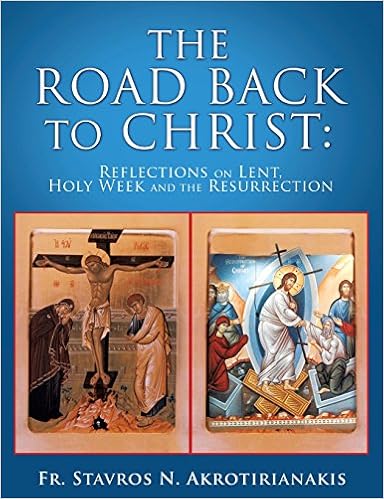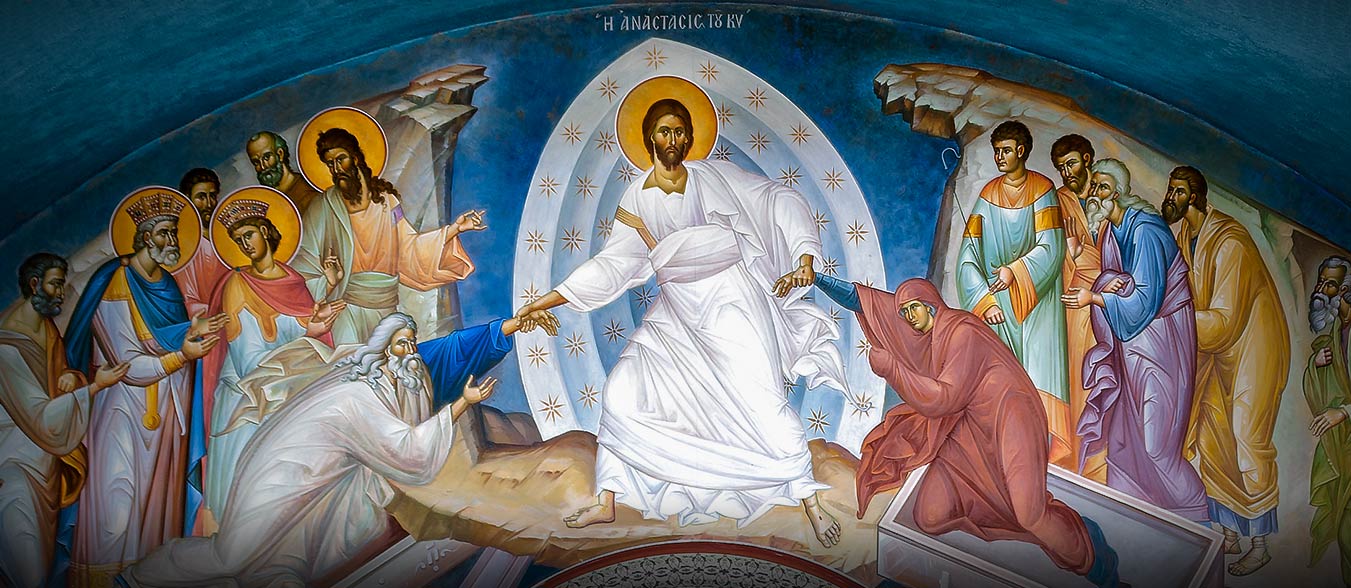Peter said, "Brethren, I may say to you confidently of the patriarch David that he both died and was buried,
and his tomb is with us to this day. Being therefore a prophet, and knowing that God had sworn with an oath to him that he would set one of his descendants upon his throne, he foresaw and spoke of the resurrection of the Christ, that He was not abandoned to Hades, nor did His flesh see corruption.
This Jesus God raised up, and of that we all are witnesses.
Acts 2:29-32
Christ is Risen!
For the next forty days, the icon of the Resurrection will be displayed in our churches. The icon of the Resurrection depicts not what happened on Easter Sunday. It actually reflects what happened on Holy Saturday. It does not show Christ coming out of the tomb, like a super hero, carrying a banner chat says "I cheated death." It shows our most Merciful Lord, descending into Hades, and raising all those who had fallen through death.
The icon depicts Christ wearing all white garments, because He is the Light of the world. The wounds in His hands and feet are visible. Christ is often shown carrying His cross, because only through the cross is the Resurrection possible. Sometimes instead of showing a Cross, the icon depicts Christ holding a scroll. In either case, the cross or the scroll, both represent the message that preached to the captives He found m hell when He descended there. Christ is standing on two doors, which are the brass gates of Hades, now broken down because of the Resurrection. They are in the shape of a cross. Scattered near the gates are the locks and keys that bound humanity to Hades.
The Most prominent figures in the icon, after the Lord, are Adam and Eve, the first human beings that God had fashioned, the symbols of a human race created in God's image and likeness, who distorted that image through sin. Adam and Eve are now given a new chance and a restored image. For Christ, who in many places is called "the second Adam," has come to earth and done what the first Adam could not. He showed that it is possible to live a life in unity with God, demonstrating faith and love, and avoiding temptation. The reward for this life is eternal life, Resurrection from the dead.
The icon depicts many of the righteous figures who preceded Christ. A young man is often depicted in the icon. This is Abel, the first person to die, killed by the hand of his brother Cain, the first person to suffer death as a result of the Fall ( Gen. 4). Moses, the one whom God spoke through to give the people the Law is shown. It was Moses who instituted the first Passover. It is very appropriate that he is present for the "new Passover," the Resurrection. David and Solomon, both kings, both ancestors of Christ, are depicted in the icon. John the Baptist, the forerunner and last of the prophets is also usually depicted.
Christ is shown grabbing the wrists of Adam and Eve. This is an important part of the icon. When people greet one another and shake hands, this denotes a position of equality, you might even say that symbolically it means meeting one another halfway. The depiction of Christ grabbing the wrist of Adam tells us that we are not equal with God. We cannot even meet God halfway, but if we reach out to God, He is ready to grasp us by the wrist to take us with Him to Paradise. This is the most hopeful part of the icon. It reminds us that we have to reach out to God in faith, and let Him take care of the rest.
In some icons of the Resurrection, Eve is depicted behind Christ, waiting her turn for her Resurrection. In some depictions her wrists are covered. In the icons where Christ is grabbing only the hand of Adam, with the other hand, Adam is gesturing toward Eve, as if asking Christ to take care of his helpmate and to save her as well.
The Resurrection was made possible only because of the crucifixion. An earthly death was required in order for the Resurrection to occur. In our lives, an earthly death is required in order to inherit eternal life and enter into the Kingdom of Heaven. The depiction in the icon assures us that those who fall through death will be raised to eternal life because of the Resurrection of the Lord. The righteous figures of the Old Testament died with faith that something greater was coming. They did not immediately go to heaven, because Jesus had not yet come and died for them, as He did for us. Through the Resurrection, when we fall through death, we are raised to Paradise by the power and the mercy of Christ.
Jesus did not "cheat" death-He destroyed the power of death. We will not cheat death either. Each of us will eventually die an earthly death, but because the Resurrection destroyed the power of death over us, when we die on this earth, we will be resurrected with Christ. The power "death" has over us will indeed be destroyed.
The service celebrated Holy Saturday morning is affectionately known as the "proti-Anastasis;' the First Resurrection. This is not a correct sentiment. Resurrection, and it occurred after the Sabbath passed. The event of Holy Holy Saturday Morning is the "First Announcement of the Resurrection," which came to those in hell. What an announcement it must have been! A hymn from the Matins (Orthros) of each Sunday (also chanted on Good Friday) says:
The assembly of the Angels was amazed beholding You numbered among the dead, O Savior, destroying the power of Death; with Yourself You raised up Adam, and freed everyone from Hades. (Evlogetaria of Sunday Orthros, and of the Orthros of Holy Saturday, Trans. by Fr. George Papadeas)
May we be so fortunate to hear this announcement when we pass away from our earthly life.
Today Hades cried out groaning:
"My power has been trampled on; the Shepherd has been crucified) and Adam He raised up.
I have been deprived of those, over whom I ruled; and all those, I had the power to swallow, I have disgorged.
He, who was crucified has cleared the tombs.
The dominion of death is no more."
Glory O Lord, to Your Cross and Resurrection.
(From the Vesperal Liturgy on Holy Saturday Morning, Trans. by Fr. George Papadeas)
May we one day be raised from the dead by the Lord!
We encourage you to participate in this journey guided by Fr. Stavros in two ways:
Purchase the book "The Road Back to Christ: Reflections on Lent, Holy Week and the Resurrection" by Fr. Stavros N. Akrotirianakis
Join the Prayer Team Daily Devotion email list and receive a reflection like this in your inbox every morning
About Great Lent, Holy Week, and Pascha
There is a 19 Sunday (18 week) period of time each year in the Orthodox Christian Church that surrounds the Feast of Pascha (Easter). The first three weeks, including four Sundays, are called the Triodion, or pre-Lenten period. The next forty days, which includes nearly six weeks and five Sundays, is called Great Lent. In the Orthodox Church, Great Lent begins on a Monday called Clean Monday, rather than Ash Wednesday, as it does in other churches. Great Lent ends on a Friday.
Holy Week follows, along with the Great and Holy Week.
The Feast of the Resurrection is called Pascha and it begins a forty-day period of celebration. After forty days, the church celebrates the Feast of the Ascension. Ten days later (fifty days after the Resurrection), the church celebrates the Feast of Pentecost. The Sunday after Pentecost is the Feast of All Saints. This ends this cycle of "movable feasts" (called this because their date moves every year), which surround the feast of Pascha.
 About "The Road Back to Christ"
About "The Road Back to Christ"
The Road Back to Christ: Reflections on Lent, Holy Week and the Resurrection is a series of short daily reflections on the scripture readings of Holy Week and the accounts of the Resurrection and post-Resurrection appearances of Christ. Designed to guide its readers through the journey, it will both inspire and reinvigorate your faith through meditation, prayer, and a deeper understanding of the Passion and Resurrection of Jesus Christ.
About Fr. Stavros
Fr. Stavros Akrotirianakis is the Proistamenos (Presiding Priest) at St. John the Baptist Greek Orthodox Church in Tampa, FL.
